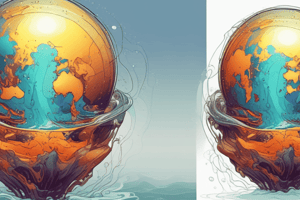Podcast
Questions and Answers
What is the primary principle of Pascal's Law?
What is the primary principle of Pascal's Law?
- Pneumatic systems can only use liquids for force transmission
- Pressure applied to a fluid is transmitted equally throughout the container (correct)
- Atmospheric pressure is irrelevant to the behavior of fluids
- Pressure in an enclosed fluid increases with temperature
A gas exerts force in a pneumatic system by being incompressible.
A gas exerts force in a pneumatic system by being incompressible.
False (B)
What happens to the volume of a fluid when temperature is increased?
What happens to the volume of a fluid when temperature is increased?
The volume increases
The study of pressure in liquids is known as __________.
The study of pressure in liquids is known as __________.
Match the following principles with their corresponding descriptions:
Match the following principles with their corresponding descriptions:
What happens when the density of an object is greater than the density of the fluid?
What happens when the density of an object is greater than the density of the fluid?
Balanced forces cause a change in the motion of an object.
Balanced forces cause a change in the motion of an object.
What is the formula for calculating pressure?
What is the formula for calculating pressure?
The unit for measuring pressure is the _____
The unit for measuring pressure is the _____
Which of the following describes unbalanced forces?
Which of the following describes unbalanced forces?
What upward force acts on an object submerged in a fluid?
What upward force acts on an object submerged in a fluid?
Match the following terms with their definitions:
Match the following terms with their definitions:
If a sealed empty water bottle is compared to a full water bottle, the _____ bottle will float.
If a sealed empty water bottle is compared to a full water bottle, the _____ bottle will float.
Flashcards
Atmospheric Pressure
Atmospheric Pressure
The pressure exerted by the layers of air surrounding the Earth that are held by the Earth's gravity. This pressure is present at about 160 km above the Earth.
Pascal's Law
Pascal's Law
Pressure applied to an enclosed fluid is transmitted with equal force throughout the entire container. This is the principle behind hydraulic and pneumatic devices.
Hydraulics
Hydraulics
The study of pressure in liquids. Hydraulic systems use liquids to transmit force and move objects.
Pneumatic Systems
Pneumatic Systems
Signup and view all the flashcards
Pressure & Volume
Pressure & Volume
Signup and view all the flashcards
Force
Force
Signup and view all the flashcards
Balanced Forces
Balanced Forces
Signup and view all the flashcards
Unbalanced Forces
Unbalanced Forces
Signup and view all the flashcards
Buoyancy
Buoyancy
Signup and view all the flashcards
Density and Buoyancy
Density and Buoyancy
Signup and view all the flashcards
Average Density
Average Density
Signup and view all the flashcards
Pressure
Pressure
Signup and view all the flashcards
Calculating Pressure
Calculating Pressure
Signup and view all the flashcards
Study Notes
Fluids and Viscosity
- Grade 8 science unit
- Chapter 9: Forces influencing the motion and properties of fluids
Force
- Anything causing a change in an object's motion
- A push or a pull
Balanced Forces
- Equal in strength
- Opposite in direction
- No movement
Unbalanced Forces
- Unequal in strength
- Cause a change in speed or direction
Mass vs. Weight
- Mass: Stays the same everywhere in the universe, measured in kilograms (kg)
- Weight: A measure of the push or pull acting on an object, measured in Newtons (N)
Buoyancy
- The upward force on an object submerged in or floating on fluids
- An object that floats has neutral buoyancy
- The buoyant force equals the weight of the fluid that the object displaces
Density & Buoyancy
- If the density of an immersed object is greater than the density of the fluid, it will sink
Which Will Float? Why?
- Examples include comparing wooden boat vs. water-logged stick, metal block vs. metal boat, and sealed empty water bottle vs. full water bottle for analysis.
Average Density
- Total mass of all substances making up an object divided by the total volume
Technologies Developed
- Personal flotation devices
- Submarines
- Hot air balloons
Pressure
- Force acting on a certain area of surface
- Larger force = greater pressure
- Smaller area = greater pressure
Calculating Pressure
- The unit for pressure is the Pascal (Pa).
- Pressure can be determined if force and area are known.
- Formula: Pressure (P) = Force (F) / Area (A)
Sample Problems
- Problems and solutions regarding calculating pressure. Example problem: An aquarium with 10,000 N of water on a 1.6 m² base, what's the pressure? Answer: 6250 Pa.
- Another example problem: Atmospheric pressure (101,200 Pa) on a hand (0.006 m²) to calculate force. Answer: 607 N
- A third example problem: Glass with a 4.9 N weight of water exerting 1700 Pa pressure. What is the area of the glass's bottom? Answer 0.0029 m².
Determine Why
- Why snowshoes can walk on deep soft snow.
- Why a garden hose's nozzle can create fast/slow flow of water.
Atmospheric Pressure
- Pressure exerted by the air layers surrounding the Earth held by Earth's gravity (approximately 160 km above Earth)
Pascal's Law
- Pressure applied to an enclosed fluid transmitted throughout the container with equal force
- Basis for hydraulic and pneumatic devices
Hydraulics
- Study of pressure in liquids.
- Hydraulic systems transmit applied force through a liquid to move something else.
Pneumatic Systems
- Use gas to exert force on gas in an enclosed space
- Compressors are necessary as gases are compressible, used to build up air pressure.
Pressure & Volume - Boyle's Law
- Increasing pressure decreases volume by the same amount
- Pressure and volume are inversely related (Boyle's Law)
Temperature and Volume
- Increasing temperature increases the volume of a fluid
Temperature and Pressure
- Increasing temperature increases the pressure of a fluid
Studying That Suits You
Use AI to generate personalized quizzes and flashcards to suit your learning preferences.




